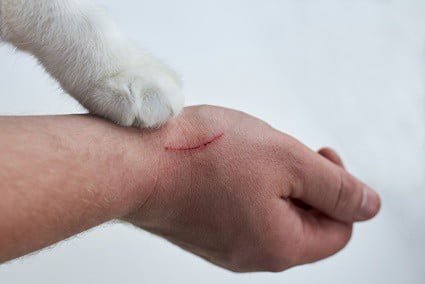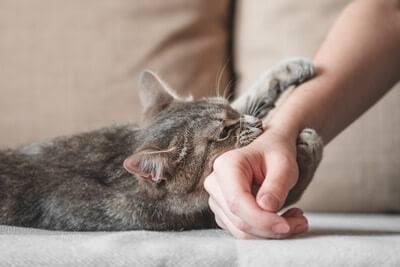A cat scratch on a finger, hand, arm or face will likely become really itchy. A quick swipe of the claws could lead to cuts, bleeding, itchiness, stinging, puffiness, or bacterial infection. The difference between a minor scratch that will heal quickly and a painful infection often has little to do with the cut itself but rather the state of the cat’s claws that inflicted the wound.
All cat scratches itch a lot because that is how wounds and abrasions heal. An infection, such as Bartonella henselae (cat scratch disease), can also cause the skin to become itchy. Other infections that make the skin itch include tetanus, cellulitis, ringworm, and toxoplasmosis. An allergy to cats will also intensify itchiness following a scratch.
We will look at how human skin reacts to a cat scratch and what factors determine the wound’s severity and healing time. We’ll then look at the most common skin infections and diseases transmitted from cats to humans.
Why Are Cat Scratches So Itchy?
Most cat scratches cause surface-level injuries, and the body will automatically start repairing itself. However, your body doesn’t consider the damage significant enough to release pain-reducing endorphins. According to The British Journal of Dermatology, the brain processes itching similarly to pain.
Itching is considered low intensity. Unless the itching becomes painful, the brain will acknowledge the discomfort but ignore it. In most cases, the itching will only last for 1-2 days. In some cases, it will take much longer to pass due to a bacterial or fungal infection. Others experience sustained itchiness due to an allergic reaction.
Allergies
If you are allergic to cats, a scratch will cause intense itching. The skin’s surface area will redden, and you may experience streaming from the eyes and sneezing. In some cases, the area around the scratched skin may break out in hives. Allergy, Asthma, and Clinical Immunology said that cats are the second most common cause of human allergies.
Infection
If you have symptoms following a cat scratch, consider whether you may have developed an infection. Your cat should be immunized against anything dangerous. All the same, it will be helpful to recognize the symptoms of an infection:
Bartonella Henselae (Cat Scratch Disease)
Bartonella henselae is the most common explanation for itchiness after a cat scratches you. This condition is known as “cat scratch disease,” or CSD.
Fleas usually cause Bartonella henselae in cats. When the cat scratches itself to relieve itching, the bacteria is trapped under the claws. It can also travel into the cat’s saliva. When a cat licks its paws to groom, the bacteria will start to multiply. Cats rarely show any reaction to Bartonella henselae, passing it on unwittingly to humans through scratches.
The scratch will start to itch naturally as the skin repairs itself. CSD can manifest later, sometimes as long as 14 days after the event. The itching will intensify, and the skin may swell. You may experience fever and lethargy.
Kittens were responsible for the vast majority of 1,200 CSD diagnoses profiled by The American Journal of Diseases in Children. Young cats are more susceptible to disease and far likelier to scratch during play.
Left alone, CSD will eventually run its course. If the itching and other side effects are particularly uncomfortable, antibiotics will be prescribed to resolve the problem.

Tetanus
Tetanus is a bacterial infection that is usually passed on by animal bites or scratches. Thankfully, it is also commonly vaccinated against, and a tetanus shot will remain effective for 10 years.
Tetanus is commonly called ‘lockjaw’ because of one of the most prominent side effects. Tetanus bacteria attack the nervous system, mainly around the neck and jaw. Moving these body parts becomes increasingly difficult, which can restrict breathing.
Tetanus will cause stiffness throughout the body. In cats, the legs are most affected. The Swiss Archive for Veterinary Science reviewed 3 cases of cats with lameness due to tetanus. All 3 cats recovered fully with the aid of medication.
If you have a cat, it is advisable to protect yourself against tetanus as scratches and bites will happen. Get a booster every 5-10 years. If you are infected due to a lack of protection, antibiotics will be required.
Cellulitis
If a cat scratches hard enough to break the skin, cellulitis becomes a risk. This is a bacterial infection that enters the body through cuts. In addition to significant itching, cellulitis will cause the skin to redden and swell. A rash will quickly form that feels hot to the touch.
Cellulitis is a result of the Pasteurella multocida bacteria. As The Journal of Feline Medicine and Surgery explains, symptoms usually present themselves within hours of the scratch taking place.
Left untreated, cellulitis can become problematic, even life-threatening. It can lead to MRSA in some cases. If the itching from a cat scratch turns into a rash, you’ll need a course of antibiotics.
Ringworm
Ringworm is a contagious fungal infection that can live within a cat’s skin and nails. Any contact with a cat can potentially pass ringworm onto humans, including scratches. A cat with ringworm will constantly scratch, leading to flailing legs. Consequently, you may be unintentionally scratched and infected with ringworm.
The infection is defined by dry, scabby skin. This manifests as circular markings, which is what gives the infection its name. Ringworm is not a parasite and does not involve worms of any kind.
Aside from unsightliness, ringworm can cause significant itching. If you notice the physical symptoms of ringworm on your skin, it should be treated ASAP. As the skin is so dry, scratching the itch risks creating open wounds and scars. Ringworm is easily treated with the aid of a topical ointment. This will resolve the itching and kill the fungus.
Ringworm is also contagious, so quarantine yourself and your cat until you’re both fully recovered. You will also need to clean and sterilize everything you came into contact with, including clothes and furniture. Failure to do so may result in a recurrence of ringworm and the associated itchiness of the skin.

Toxoplasmosis
There is a slim chance of being infected with toxoplasmosis from a cat scratch. The chance is slim because the disease is not carried in feline saliva. Simply licking paws will transfer the bacteria to a cat’s claws, and cats shed the bacteria that cause this infection through feces.
According to Veterinary Parasitology, most infections involve handling contaminated waste. A dirty litter tray means that feline waste can become trapped in a cat’s claws. If the cat scratches and breaks the skin, the infection can be passed on to humans. This is unlikely, but it’s not impossible.
Most cats show no symptoms of toxoplasmosis. If your cat has the condition, it may display run a fever, become lethargic, and lose its appetite.
Be mindful of toxoplasmosis risk if you are pregnant or have children, as it can cause a range of health concerns in children and fetuses, including blindness.
Bubonic Plague
Bubonic plague is caused by a strain of bacteria called yersinia pestis. Cats can catch the plague by eating infected mice or being bitten by fleas. According to The Journal of the American Medical Association, cats can pass on the plague to humans via scratching. Caught sufficiently early, the plague can be treated with antibiotics.
Treating the Cause of the Itchiness
If you have been scratched by your cat, wash the area immediately with soapy water for about 2 minutes. Apply an antibiotic ointment as a precaution.
If the wound is still bleeding after washing, hold a gauze against the wound and apply a bandage once the bleeding subsides. Check the wound, and change your dressing daily. If you notice swelling or pus in and around the wound, then an infection has occurred. If so, you will need a course of antibiotics to clear up the infection.

